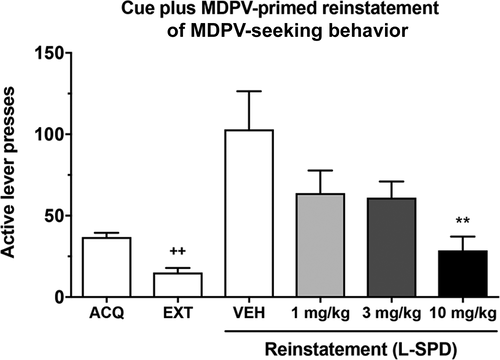当前位置:
X-MOL 学术
›
ACS Chem. Neurosci.
›
论文详情
Our official English website, www.x-mol.net, welcomes your feedback! (Note: you will need to create a separate account there.)
Dopamine D1-Like Receptor Agonist and D2-Like Receptor Antagonist (-)-Stepholidine Reduces Reinstatement of Drug-Seeking Behavior for 3,4-Methylenedioxypyrovalerone (MDPV) in Rats.
ACS Chemical Neuroscience ( IF 5 ) Pub Date : 2018-04-06 , DOI: 10.1021/acschemneuro.7b00510 Callum Hicks 1, 2 , Peng Huang 1, 2 , Linnet Ramos 1, 2 , Sunil U Nayak 1, 2 , Yohanka Caro 1, 2 , Allen B Reitz 3 , Garry R Smith 3 , David Y-W Lee 4 , Scott M Rawls 1, 2 , Lee-Yuan Liu-Chen 1, 2
ACS Chemical Neuroscience ( IF 5 ) Pub Date : 2018-04-06 , DOI: 10.1021/acschemneuro.7b00510 Callum Hicks 1, 2 , Peng Huang 1, 2 , Linnet Ramos 1, 2 , Sunil U Nayak 1, 2 , Yohanka Caro 1, 2 , Allen B Reitz 3 , Garry R Smith 3 , David Y-W Lee 4 , Scott M Rawls 1, 2 , Lee-Yuan Liu-Chen 1, 2
Affiliation

|
Psychostimulant reinforcement is mediated by stimulation of both dopamine (DA) D1-like and D2-like receptors, suggesting that pharmacotherapy agents with a dual DA receptor mechanism may be useful for managing psychostimulant abuse. (-)-Stepholidine (L-SPD) is a Chinese herbal extract that functions as a D1-like receptor agonist and D2-like receptor antagonist. L-SPD has been shown to attenuate the reinforcing effects of heroin; however, its effects on the synthetic cathinone 3,4-methylenedioxypyrovalerone (MDPV) have not been examined. The current study determined the effects of L-SPD on reinstatement of MDPV-seeking behavior in the drug intravenous self-administration (IVSA) and conditioned place preference (CPP) paradigms. To determine whether the effects of L-SPD were specific to psychostimulant reinforcement, we also examined its effects on sucrose-seeking behavior. Using a locomotor activity assay, we tested the locomotor effects of L-SPD, as well as its effects on MDPV-induced hyperactivity. The results of a battery of in vitro binding and functional assays confirmed that L-SPD functioned as a D1-like receptor agonist and D2-like receptor antagonist. In behavioral experiments, L-SPD dose-dependently attenuated cue plus MDPV-primed reinstatement of MDPV-seeking behavior in the IVSA model. The highest dose of L-SPD also attenuated MDPV-primed reinstatement of MDPV CPP, as well as cue-induced reinstatement of sucrose-seeking. L-SPD had no significant locomotor effects, and did not modulate the robust hyperactivity induced by MDPV. The current findings show for the first time a robust reinstatement effect with MDPV, which can be reduced by L-SPD. These results establish a role for DA receptors in drug-seeking behavior for MDPV.
中文翻译:

多巴胺D1受体激动剂和D2受体拮抗剂(-)-Stepholidine降低大鼠3,4-亚甲二氧基吡咯烷酮(MDPV)的寻药行为的恢复。
多巴胺(DA)D1样和D2样受体的刺激介导了精神兴奋剂的增强,这表明具有双重DA受体机制的药物治疗剂可能对管理精神兴奋剂滥用有用。(-)-Stepholidine(L-SPD)是一种中草药提取物,具有D1样受体激动剂和D2样受体拮抗剂的功能。L-SPD已显示减弱海洛因的增强作用。但是,尚未研究其对合成卡西酮3,4-亚甲基二氧基吡咯烷酮(MDPV)的影响。当前的研究确定了L-SPD在药物静脉自给药(IVSA)和条件性位置偏爱(CPP)范例中对MDPV寻求行为恢复的影响。为了确定L-SPD的作用是否专门针对心理刺激增强剂,我们还研究了其对寻求蔗糖行为的影响。使用运动活性测定法,我们测试了L-SPD的运动作用及其对MDPV诱导的机能亢进的作用。一系列体外结合和功能测定的结果证实,L-SPD充当D1样受体激动剂和D2样受体拮抗剂。在行为实验中,IVSA模型中L-SPD剂量依赖性地减弱了提示并加上MDPV引发的MDPV寻求行为的恢复。L-SPD的最高剂量也减弱了MDPV引发的MDPV CPP恢复,以及提示诱导的蔗糖恢复。L-SPD没有明显的运动作用,也没有调节由MDPV诱导的强健的机能亢进。目前的发现首次显示了MDPV的强大恢复作用,而L-SPD可以降低这种恢复作用。
更新日期:2018-03-29
中文翻译:

多巴胺D1受体激动剂和D2受体拮抗剂(-)-Stepholidine降低大鼠3,4-亚甲二氧基吡咯烷酮(MDPV)的寻药行为的恢复。
多巴胺(DA)D1样和D2样受体的刺激介导了精神兴奋剂的增强,这表明具有双重DA受体机制的药物治疗剂可能对管理精神兴奋剂滥用有用。(-)-Stepholidine(L-SPD)是一种中草药提取物,具有D1样受体激动剂和D2样受体拮抗剂的功能。L-SPD已显示减弱海洛因的增强作用。但是,尚未研究其对合成卡西酮3,4-亚甲基二氧基吡咯烷酮(MDPV)的影响。当前的研究确定了L-SPD在药物静脉自给药(IVSA)和条件性位置偏爱(CPP)范例中对MDPV寻求行为恢复的影响。为了确定L-SPD的作用是否专门针对心理刺激增强剂,我们还研究了其对寻求蔗糖行为的影响。使用运动活性测定法,我们测试了L-SPD的运动作用及其对MDPV诱导的机能亢进的作用。一系列体外结合和功能测定的结果证实,L-SPD充当D1样受体激动剂和D2样受体拮抗剂。在行为实验中,IVSA模型中L-SPD剂量依赖性地减弱了提示并加上MDPV引发的MDPV寻求行为的恢复。L-SPD的最高剂量也减弱了MDPV引发的MDPV CPP恢复,以及提示诱导的蔗糖恢复。L-SPD没有明显的运动作用,也没有调节由MDPV诱导的强健的机能亢进。目前的发现首次显示了MDPV的强大恢复作用,而L-SPD可以降低这种恢复作用。



























 京公网安备 11010802027423号
京公网安备 11010802027423号